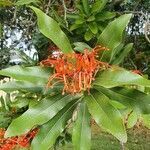Tree, 10(-20-30) m by 30 cm; branchlets terete, younger parts tomentulose, soon glabrescent. Leaves either undivided, oblong-lanceolate, 13-27 by 3-7 cm — or irregularly pinnatisect and up to 30 cm long, with 1-4 oblong lobes on each side — mostly obtuse at the apex, attenuate into the petiole at the base, subcoriaceous, glabrous; forks in divided leaves with a (?hydathodal) gland; nerves 10-15 pairs, pinnate, with more or less conspicuous intermediate ones between, slightly prominent underneath, veins finely and densely reticulate on both faces; petiole glabrous, 1.5-2.5 cm. Peduncles axillary or terminal on lateral short-shoots, glabrescent, either 2 or more together in an umbel, or several at some distance forming a short broad raceme, each peduncle 5-10 cm bearing an umbel of (6-) 12-20 bright red or orange-red flowers. Pedicels c. 1.25 cm, radiating in one plane from the dilated apex of the peduncle. Perianth-tube shortly rusty-pubescent, straight, narrowed upwards, incl. the limb (2.5-)3 cm in anthesis; limb recurved, globular, about 4 mm across. Anthers yellow. Disk gland semi-annular, blackish when dry, c. 2 mm high. Ovary densely brownish-pubescent, on a less densely pubescent to glabrescent, thick, up to 2 cm accrescent stipe. Style glabrous, c. 2 cm. Ovules 12-14. Fruit dry, c. (6-) 10 cm long, 2-2.5 cm broad, narrow-oblong, attenuate at both ends, opening lengthwise on one side and then boat-shaped, but flattening out after maturity, hard-coriaceous. Seeds thin, closely packed and overlapping, c. 25 by 7 mm.
More
Tree to 30 m tall. Branchlets terete, ferruginous-tomentose, glabrescent. Leaves variable from simple to deeply pinnately-lobed; petiole to c. 2.5 cm long; lamina with undulate margins, discolorous, dark glossy green above, paler beneath; main veins and reticulations well-defined particularly beneath; lobed leaves with lamina to 48 cm long; simple leaves with lamina obovate, oblanceolate to elliptic, to 23 cm long. Conflorescence terminal or in upper leaf axils, minutely hairy; peduncles simple, 4-10 cm long, sometimes several arising from a common axis; umbels of 6-20 flowers. Flowers 25-38 mm long, bright red, with a prominent, globular, yellowish limb in bud; pedicels 14 mm long. Hypogynous gland prominent, encirling c. two-thirds of base of gynophore. Follicles cylindrical, 5-10 cm long, greyish-brown, with short rusty hairs; stalk to 4 cm long overall, forming a knee-like joint at junction of pedicel and gynophore. Seeds ±oblong, to c. 36 mm long including wing.
Uses. Wood of a light colour, close in grain, tough and firm, good for cabinet-work, brake-blocks, building, framing, flooring. Often cultivated for its brilliant and remarkably symmetrical inflorescences, similar to a wheeled umbel, therefore called wheel-tree. According to Backer I.c. sometimes cultivated in the mountains of W. Java as an ornamental tree.


